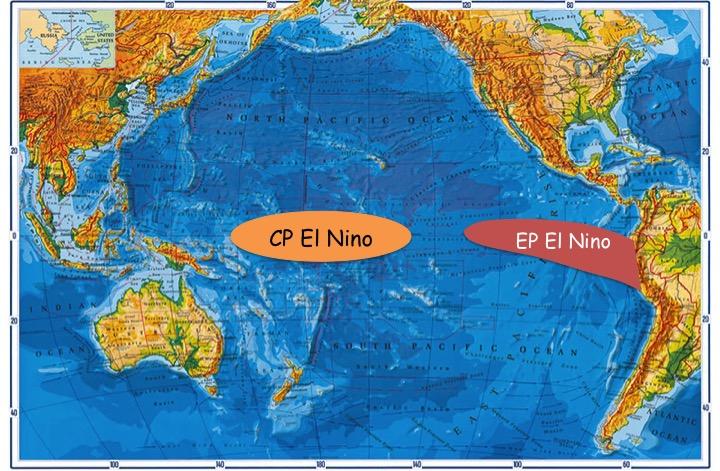Scientists find why CP El Niño is harder to predict than EP El Niño

In addition to the eastern Pacific El Niño which we have been quite familiar with, a second El Niño in the central Pacific has emerged. Credit: Fei Zheng
Recently, a new type of El Niño [central Pacific (CP) El Niño] has emerged, in which maximum sea surface temperature (SST) anomalies are confined mostly to the CP–different to the canonical type [eastern Pacific (EP) El Niño], in which the maximum SST anomalies are located in the eastern Pacific.
The more frequent occurrence of CP El Niño and its different impacts on global climate compared to EP El Niño have been well documented.
However, a systematic examination of the performance of climate models in predicting the two types of El Niño had yet to be undertaken, and it remained controversial as to whether the predictability differs among state-of-the-art climate models.
Prof. Fei Zheng, from the Institute of Atmospheric Physics, Chinese Academy of Sciences and Prof. Jin-Yi Yu, from the University of California, Irvine, explored the performance of the IAP's ENSO ensemble prediction system with respect to the two types of El Niño, focusing on the nine EP El Niño and twelve CP El Niño events that have occurred since 1950.
“We found that the skill scores for EP events were significantly better than those for CP events at all lead times,” says Zheng, “the possible reasons are related to the systematic forecast biases coming mostly from the prediction of CP events; and systematic error characterized by an overly warm eastern Pacific during the spring season, indicating a stronger spring prediction barrier for CP El Niño.”
Further improvements to coupled atmosphere-ocean models in terms of CP El Niño prediction should be recognized as a key and high-priority task for the climate prediction community. The study was recently published in Advanced in Atmospheric Sciences.
Media Contact
All latest news from the category: Earth Sciences
Earth Sciences (also referred to as Geosciences), which deals with basic issues surrounding our planet, plays a vital role in the area of energy and raw materials supply.
Earth Sciences comprises subjects such as geology, geography, geological informatics, paleontology, mineralogy, petrography, crystallography, geophysics, geodesy, glaciology, cartography, photogrammetry, meteorology and seismology, early-warning systems, earthquake research and polar research.
Newest articles

Properties of new materials for microchips
… can now be measured well. Reseachers of Delft University of Technology demonstrated measuring performance properties of ultrathin silicon membranes. Making ever smaller and more powerful chips requires new ultrathin…

Floating solar’s potential
… to support sustainable development by addressing climate, water, and energy goals holistically. A new study published this week in Nature Energy raises the potential for floating solar photovoltaics (FPV)…

Skyrmions move at record speeds
… a step towards the computing of the future. An international research team led by scientists from the CNRS1 has discovered that the magnetic nanobubbles2 known as skyrmions can be…




















